Needed: Fresh Eyes to Improve New York’s Constitution (Part II)

This is part two of a two-part series entitled Needed: Fresh Eyes to Improve New York’s Constitution. Read part one: New York’s Mandarin Constitutional Culture.
Implementing First Amendment Values in the 21st Century
Drawing an analogy between Chinese Mandarin culture of the 18th and 19th centuries and New York’s constitutional culture in the early 21st Century, I argued in Part I of this series that New York’s current debate over constitutional reform lacks fresh ideas for systemic reasons. One reason stems from the incentive of legislatures to veto democratic reforms in areas, such as legislative redistricting, term limits, and ballot access, where they have a conflict of interest with the public. That’s a problem because for democratic innovators to do the difficult and costly work of innovation, they need to believe that their ideas have a chance of being implemented. Another reason is that the young are usually society’s innovators. But New York’s mandarin constitutional reform culture favors the old.
I propose an idea emblematic of the type that should but hasn’t been part of the current debate over New York State constitutional convention based reform. Its goal is to dramatically enhance First Amendment values in the election process, and it is premised on the close but rarely recognized link between technology and constitutional design. Specifically, new information technology has made ballot access ripe for constitutional innovation.
Currently, New York government has exclusive control over both ballot data and ballot interfaces. I propose requiring it to give up control over ballot interfaces while retaining its control over ballot data.
In the pre-internet era of paper ballot technology, this couldn’t be done without sacrificing important democratic values, notably the secret ballot. Until the late 19th Century, control of ballot data and interfaces were separate. For example, political parties would print pre-filled ballots (called “party tickets”) and distribute them to voters. But this rightly came to be viewed as intolerable because the party officials and others who handed out the ballots at the polling booth could keep track of which ballot a voter submitted and reward voters who submitted their preferred, prefilled ballot. The solution was the “secret ballot,” which is now mandated in New York’s Constitution and gave government control over the ballot interface as well as ballot data.
Unfortunately, giving government control over the ballot interface came with huge costs. It gave legislators much greater control over both which candidates are included on the ballot presented to voters and how information about them, including endorsements (popularly known as party labels), are used. Such control is inconsistent with First Amendment values of public participation and free speech.
Modern information technology makes it possible to separate ballot data and interfaces without the compromises associated with print technology. Specifically, voters should be allowed to choose non-government ballot interfaces that are directly linked to public ballot data. Ironically, we currently allow the public access to non-government media, except the media most vital to preserve First Amendment values: the ballot interface.
Online voting, such as has already been successfully implemented in Estonia, could one day greatly improve the implementation of this idea. But its successful implementation does not depend on online voting. As with absentee voting, the voter could simply print a machine-readable ballot with the necessary data and then either bring it to the voting booth or mail it in.
Effectively separating ballot data and interfaces is a non-trivial matter of both technology and institutional design. It is probably comparable in difficulty to the online voting system developed by Estonia. But it also isn’t a moonshot. Most important, it would generate a huge payoff, especially for down ballot elections where ballot interfaces have been most influential.
Candidates, interest groups, and political parties currently spend billions of dollars every major election cycle on providing repetitious, soundbite-long, and often misleading information trying to influence voters. Not only is the quality of information very poor, but the high cost of paying for it heavily tilts the playing field in favor of deep-pocketed special interests.
Providing a voter friendly ballot interface when voters are most motivated and able to use election-related information would radically reduce barriers to political entry, thus revolutionizing campaign finance and providing a fundamentally different paradigm for campaign finance reform.
Legislatures opposed to separating ballot interfaces from data will use the admittedly difficult technological challenges to doing so as their primary excuse. But the primary roadblock to implementing this innovation is no longer technological; it is that incumbent legislators—regardless of party—view such a separation as a threat to their incumbency advantage. For them, opening the ballot interface is tantamount to giving free publicity to their opponents.
Thus, in New York, only through a constitutional convention can this barrier to political competition be removed.
Government control over ballot interfaces may one day be viewed as hostile to First Amendment values as the 17th century British government’s practice of licensing access to the printing press. A state constitutional convention is the most plausible institutional mechanism to address this First Amendment abomination. But if New York’s mandarin state constitutional culture persists, that won’t happen. A similar failure to innovate didn’t work out well for the late 18th Century Chinese when they were the world’s leading power.
New York’s motto, excelsior, for “Ever Upward,” clearly indicates that preserving the status quo at the expense of the people isn’t the goal. But if Exelsior excludes modernizing New York’s constitution, then in the long run the rest of the Excelsior agenda won’t matter.
*************
Estonia’s 36-year old prime minister explains Estonia’s e-voting system for parliament. According to Freedom House, the world’s leading source of data on the comparative democratization of countries, Estonia ranks #1 on Internet freedom.
***
J.H. Snider, the president of iSolon.org, is the editor of The New York State Constitutional Convention Clearinghouse and author of Does the World Really Belong to the Living? The Decline of the Constitutional Convention in New York and Other US States, 1776–2015.
***
Have an op-ed idea or submission for Gotham Gazette? Email This email address is being protected from spambots. You need JavaScript enabled to view it.
Investing in the Parks System New York City Deserves
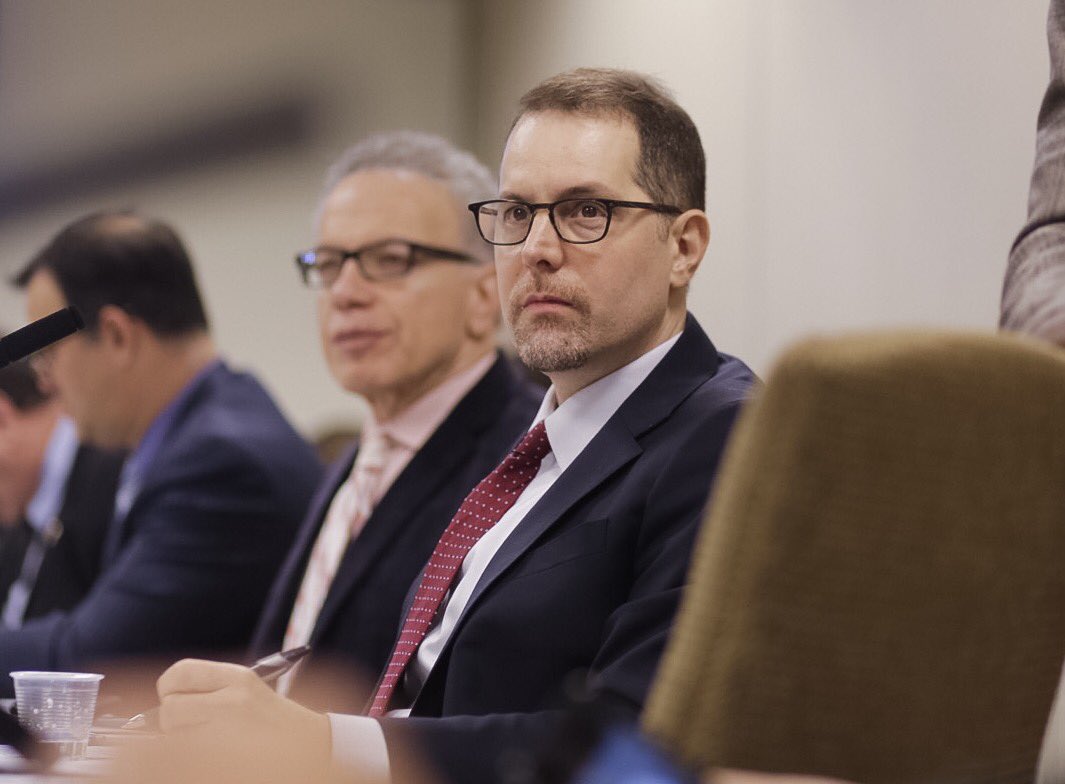
Council Member Levine, the author (photo: William Alatriste)
The numbers are startling: 42 million visitors per year in Central Park -- double the number of visitors to Disney World. Over 7 million people visit the High Line annually and 5 million visit Bryant Park. On a peak summer weekend 127,000 visit Brooklyn Bridge Park.
Park use in New York City is surging. And with the population in the five boroughs continuing to grow and tourism booming, this trend will surely continue.
But the story is not the same everywhere in our city. The marquee parks that are increasingly overwhelmed with visitors fortunately have the benefit of millions of dollars in private contributions to help them manage the onslaught. These funds enable them to provide the extra staffing needed to keep their parks looking beautiful despite the record levels of trampling.
Meanwhile, hundreds of parks in the city’s low- and moderate-income neighborhoods must survive on public funds alone. And those funds are often not enough to keep up with maintenance in the face of rising usage.
In the 1960s, New York City’s Parks Department had full-time staff of over 7,500. Since then the city’s population has grown by 1 million, but today the full-time headcount is just over 4,000. Over the decades the share of our city’s total budget devoted to parks has fallen from 1.7% to under 0.6% today. We now spend less per capita on our parks than San Francisco, Minneapolis, Seattle, and Washington, D.C.
We need to reverse this trend. The Parks Department budget must increase to meet swelling demand, and to ensure that low- and moderate-income neighborhoods have the great parks they deserve.
But we also need to grow our park system to serve a rising population.
This is especially true in neighborhoods being upzoned for greater residential density, including East New York, East Harlem, and the Jerome Avenue corridor in the Bronx. If those areas are to remain livable as they gain thousands of additional residents, they will require not just new schools and expanded transit capacity, but more open space as well.
Many neighborhoods throughout the five boroughs face a shortage of park space even without population growth: one-quarter of New Yorkers today have no park within a ten-minute walk from their home. We need new parks to fill in these gaps, most of which are in the outer boroughs.
Inspiring, transformative park projects are waiting for funding all over the city.
The Queensway would convert an abandoned rail line in central Queens into a 3.5-mile linear park. The BQ Green would deck-over part of the BQE, creating green space in park-starved Bushwick. The Lowline, on the Lower East Side, would turn an abandoned trolley terminal into the world’s first underground park, in an area where open space is being gobbled up by a building boom.
We also must pick up the pace of restoration of our city’s natural areas -- 10,000 acres of forest, wetlands, and grasslands in the five boroughs which many New Yorkers don’t even know exists. Modernized and better mapped trails will allow more people to discover these marvelous natural places which are often just a subway ride away.
And let’s find an environmentally sensitive way to open up parts of our park system that are now off-limits to the public, like the spellbinding North Brother Island -- a Lost City off the coast of the South Bronx, long ago overtaken by the forest. Let’s find a way to open up nearby Hart Island, whose 120 scenic acres are home to our city’s potter’s field and a century-and-a-half of history.
Mayor de Blasio’s preliminary budget for the coming fiscal year does little to reverse the trend of inadequate funding for our parks system. It leaves staffing flat and holds the Parks Department to less than 0.6% of the total city budget. It is critical that these numbers improve during negotiations with the City Council in the months leading up to the budget’s final passage in June.
A thriving park system isn’t just a luxury in a dense city of 8.5 million people. It’s essential to livability. Let’s invest now to ensure that every corner of the five boroughs remains livable for the years and decades to come.
***
City Council Member Mark Levine represents parts of Upper Manhattan and is chair of the Council's parks committee. On Twitter @MarkLevineNYC.
***
Have an op-ed idea or submission for Gotham Gazette? Email This email address is being protected from spambots. You need JavaScript enabled to view it.
Business Contributions and Campaign Finance in New York: Deep Historical Roots

(photo: The Governor's Office on Flickr)
Business money and New York politics
The New York Joint Commission on Public Ethics, an oversight panel, recently proposed legislation to increase the requirements for lobbyists to disclose their political fundraising. The recommendation would help show the ways in those seeking to influence policy by day are raising money for policy-makers by night.
Blair Horner, legislative director for the New York Public Interest Group, one of several groups critical of New York's loose campaign finance laws, said recently that during this time in the legislative session in Albany, "It's pretty much pedal-to-the-metal when it comes to [legislators] hitting up lobbyists for campaign contributions."
The New York State League of Women Voters called for "a significant reduction of all contribution limits, special 'pay-to-play' limits on contributions by lobbyists and those who do business with the state and eliminating the LLC loophole." The Citizens Union, another reform group, has also called for campaign finance reform in New York.
In his annual message to the Legislature, the governor denounced "political contributions by business corporations" as "morally wrong....Their contributions are influenced by business and not by patriotism and, like other investments, are made in the hope and expectation of financial return or to avert threatened pecuniary injury." The governor recommended making political payments by corporations a criminal offense.
It almost sounds like Governor Andrew Cuomo last year and this year. But actually, it was Governor Frank W. Higgins, in 1906.
Concern with the influence of campaign contributions has deep historical roots here in New York.
Scandals led to New York's first campaign finance law
Governor Higgins was reacting to two scandals.
In the 1904 presidential campaign, the New York World alleged that business interests were funding the campaign of President Theodore Roosevelt, hoping to curry favor with his administration. His Democratic challenger, former New York Chief Judge Alton Parker, charged that TR was receiving large contributions from New York railroad magnate Edwin H. Harriman and Wall Street banker J.P. Morgan. "Would the public interest be safe in the hands of a party the greater part of whose campaign funds had been contributed by corporations and trusts?" Parker asked. Roosevelt denounced the charges as "unqualifiably and atrociously false."
Historians now know Parker was right but at the time he could not produce concrete proof. Roosevelt was dissembling. For instance, he had secretly asked Harriman to contribute to the Republican Party in New York State with the plea that its gubernatorial candidate, then-Lieutenant Governor Frank Higgins, needed help getting elected. Harriman complied, raising about $250,000.
But, as TR fully realized, supporting the party and Higgins in New York also meant indirectly supporting Roosevelt himself -- he was running for president on the same ticket. TR had directed that some business contributions be returned to their donors but campaign aides had not followed through and the president had not really checked.
On the other hand, Parker, too, received large contributions from business interests, mostly in New York City, though not as much as Roosevelt. There were rumors in the press, but nothing specific came out in public.
TR won in a landslide. But public concern about campaign finance was sharpened.
The next year, the Legislature investigated the management of insurance companies, uncovering a corrupt pattern of insider trading, fraudulent accounting, and deceptive sales practices. But the committee's counsel, Charles Evans Hughes (who would later himself be a reformist governor), dug deeper and got company officials to admit to providing large campaign contributions for state and federal offices. Hughes pressed U.S. Senator Thomas C. Platt, the long-time boss of the state Republican Party, about the real purpose of the contributions:
"Hughes: To see that the legislature, for example, did not enact legislation which they thought hostile to their policyholders?
"Platt: That is what it would amount to.
"Hughes: Is not that the way it really comes about, Senator, that they use of these contributions in the election of candidates to office puts the candidates in more or less of a moral obligation not to attack the interests supporting [them]?
"Platt: That is what would naturally be involved."
The contributions were not really bribes. They were more in the vein of what we now call building influence or access.
But the 1904 and 1905 scandals stirred public opinion. Higgins, whose 1904 campaign had benefitted from business campaign contributions as indicated above, did not mention that fact when he made his strong appeal to the Legislature for action in 1906.
After Governor Higgins' speech, the Legislature passed three pieces of legislation. One prohibited corporate campaign contributions. Another required candidates and political committees to make public a record of their campaign receipts and expenditures. A third redefined corrupt practices by defining what campaign expenditures were acceptable.
Closing one door, opening another
The campaign finance law was changed and updated in 1949 and 1976. It currently provides that corporations are limited to political donations of $5,000 a year, according to the New York State Board of Elections.
But there is a large loophole or exception, through Limited Liability Companies (LLCs). The New York State Department of State offers this definition of an LLC:
"A limited liability company (LLC) is an unincorporated business organization of one or more persons who have limited liability for the contractual obligations and other liabilities of the business. The LLC is a hybrid form that combines corporation-style limited liability with partnership-style flexibility. The owners of an LLC are “members” rather than shareholders or partners. A member may be an individual, a corporation, a partnership, another limited liability company, or any other legal entity. An LLC may organize for any lawful business purpose or purposes."
LLCs are flexible, versatile entities. But in 1976, the State Board of Elections decided that, when it came to campaign contribution, LLCs were more like individuals than corporations or partnerships. That meant they were subject to much higher limits on contributions, and much less stringent reporting requirements. The Board's decision was based on a since-changed federal definition.
This opened the way for huge contributions. The names of individuals behind LLCs are not disclosed. LLCs now routinely make large contributions to candidates for governor, other statewide offices, and the Legislature. It has become a way for monied interests to influence elections and gain access and influence.
Good government groups have called for the "LLC loophole" to be closed for several years. In 2015, the Board considered eliminating it but deadlocked, two to two, and issued a decision that it was up to the Legislature to change it. Governor Cuomo, a Democrat, and the Democratic Majority in the Assembly support the change but the Senate, which is controlled by Republicans, so far has balked. Cuomo and many legislators benefit from the contributions, so their efforts toward repeal look half-hearted.
In 2015, the Brennan Center for Justice at the New York University School of Law went to court to force the Board to change its ruling. Last year, State Supreme Court Justice Lisa Fisher dismissed the case, finding that the statute of limitations for challenging the Board's 1996 action has passed. She also characterized the issue as a “political question best suited for resolution through legislative action.”
Money and politics: what can citizens do?
One hundred and eleven years after New York's first campaign finance regulation, the state is once again searching for a solution to the issue. Good government groups and the Joint Commission on Public Ethics have set forth proposals, including closing the LLC loophole and increasing disclosure requirements. Governor Cuomo mostly seems to have given up. He has remarked that it is now up to the people to get the loophole closed.
As it turns out, the people may have a chance to do that this fall, when New Yorkers vote on whether to hold a state constitutional convention. A convention could alter the way we conduct and finance campaigns, including even proposing public funding of political campaigns.
Actually, an amendment to the constitution prohibiting corporate campaign contributions was proposed before in a constitutional convention:
"The idea of this section...is to prevent the great moneyed corporations of the country from furnishing the money with which to elect members of the legislature of this State in order that these members of the legislature may vote to protect the corporations," said its sponsor. "It strikes...at a constantly growing evil in our political affairs, which has, in my judgment, done more to shake the confidence of the plan people of small means in this country in our political institutions than any other practice which has ever obtained since the foundations of our government."
The amendment's sponsor acknowledged that the contributions were not akin to bribes. He said companies regarded them as "investments" made to get an "inexpressible sympathy between the candidate and the contributor."
Like the quotation from Governor Higgins in 1906, these words sound applicable to our situation today. But these were the words of New York attorney and statesman Elihu Root, a Republican, and the constitutional convention was in 1894.
Political insiders who were delegates to the convention opposed the amendment. It would cut off their campaign contributions. Democratic delegates derided it as a political charade. One Democrat said that "the whole business was buncombe, pure and simple, and [proposed] only for the sake of allowing Republicans to deliver patriot speeches for the record and their constituents." The proposed amendment was tabled and did not find its way into the constitution.
This year, New Yorkers have an opportunity to try again to get at the issue of money in politics. If the state's three branches of government -- governor, the Legislature, and the courts -- can't resolve the issue, then the voters may decide that is one strong reason to vote for a constitutional convention in November.
Of course, political insiders could bottle up reform amendments as they did with Root's proposal in 1894. On the other hand, with so much public interest and concern about the issue, publicity by good government groups and the media, and given the recent bouts of corruption in Albany, the prospects for changing the constitution to deal with the issue seem very good.
***
Dr. Bruce W. Dearstyne's latest book is The Spirit of New York: Defining Events in the Empire State's History, published in 2015 by SUNY Press.
***
Have an op-ed idea or submission for Gotham Gazette? Email This email address is being protected from spambots. You need JavaScript enabled to view it.
Needed: Fresh Eyes to Improve New York’s Constitution (Part I)

(photo: Samar Khurshid/Gotham Gazette)
This is part one of a two-part series entitled Needed: Fresh Eyes to Improve New York’s Constitution. Read part two here.
New York’s Mandarin Constitutional Culture
During the last 500 years, a culture of innovation set off the West from the rest of the world, allowing it to achieve far higher living standards. Incentives for innovation have remained strong in the private sector but have greatly weakened in the public sector.
The United States and its most innovative state, New York, have led the West in innovation. During the 18th and 19th centuries, this included leading the world in constitutional innovation, which is arguably the most important type of public sector innovation. But present-day New Yorkers and their opinion leaders are as allergic to such innovation as Chinese emperors and Mandarins were in the 18th and 19th centuries.
Symbolic of the decline are the stale ideas currently dominating New York’s debate over whether to call a state constitutional convention. Every 20 years the state constitution mandates that New York voters be asked whether they want to convene another state constitutional convention. To date, New York has convened nine proposing and two ratifying conventions. On November 7, 2017, this question is next on the ballot.
The unique democratic function of a state constitutional convention is to provide a mechanism to bypass the state Legislature’s veto power over constitutional amendment when the Legislature’s institutional interests conflict with those of the public. The result is that not only the Legislature but also the most powerful special interest groups that thrive exercising influence over the Legislature are implacable enemies of state constitutional conventions.
The current debate in New York has been dominated by opinion leaders who were already adults when New York’s last constitutional convention convened in 1967. They have much to bring to the current debate, especially a sense of history, and we are lucky to have them. But too often their and their allies’ reform ideas are from a different generation. Their ideas may be improvements over the antiquated status quo, but so were the now obsolete audio and video tape recorders from the second half of the 20th Century that replaced paper-based recording technologies.
In contrast, when Thomas Jefferson wrote the U.S. Declaration of Independence and when James Madison and Alexander Hamilton both participated at the 1787 national constitutional convention and then defended it in the Federalist Papers, they were all under 40 years of age. The three leading figures behind the design of New York’s first constitution in 1777 -- Gouverneur Morris, Robert Livingston, and John Jay -- were all 30 years of age or younger. They brought to the design of our federal and state governments fresh eyes and many innovations from which we have greatly benefited.
A better balance between the old and new is needed. Unfortunately, getting true innovators involved in democratic reform is one of the hardest parts of democratic reform, as the rewards for such innovation are often negligible at best. Consider just one reason: why do the immensely difficult and costly work of developing an innovation that has no chance of being implemented because of a legislature’s institutional conflict of interest?
A state constitutional convention is one of the few institutional mechanisms in our democracy with the potential to stimulate fresh thinking. It would be a tragedy to squander that opportunity.
My greatest worry is not, as convention opponents argue, that special interests will derail a convention by getting it to place harmful proposals on the ballot. If special interests do corrupt a convention—and they will certainly try—the people have shown they can be trusted to veto the resulting proposals. This, after all, is why New York’s and other states’ most powerful special interests hate the institution of the state constitutional convention and have spent so much to oppose convening one: they are more confident in their typical, ongoing control over legislatures.
A greater worry should be that New York’s opinion leaders, including its press, academics, advocates, and politicians, will continue to treat democratic innovators the way Chinese Mandarins did during the era when the United States was founded. New York needs to breed a new generation of Alexander Hamiltons, and the time to begin that effort is now.
New York, despite its vast human and material wealth, has become too much like 18th century China, when China was a vastly larger, more sophisticated, and more prosperous country than ours but became arrogant and thus complacent in its superiority. New Yorkers should look to democracies, including Estonia, Iceland, and Sweden—two of them about the size of New York when it drafted its first constitution—where a can-do culture of democratic innovation survives.
New York, like China thought it was for hundreds of years, remains at the center of the world. But it won’t remain there unless it proves capable of developing an outward looking culture characterized by both constitutional humility and innovation.
This is part one of a two-part series entitled Needed: Fresh Eyes to Improve New York’s Constitution. Read part two: Implementing First Amendment Values in the 21st Century. And, read other columns by J.H. Snider here.
***
J.H. Snider, the president of iSolon.org, is the editor of The New York State Constitutional Convention Clearinghouse and author of Does the World Really Belong to the Living? The Decline of the Constitutional Convention in New York and Other US States, 1776–2015.
***
Have an op-ed idea or submission for Gotham Gazette? Email This email address is being protected from spambots. You need JavaScript enabled to view it.
Trump's Speech, a Nightmare for Democrats
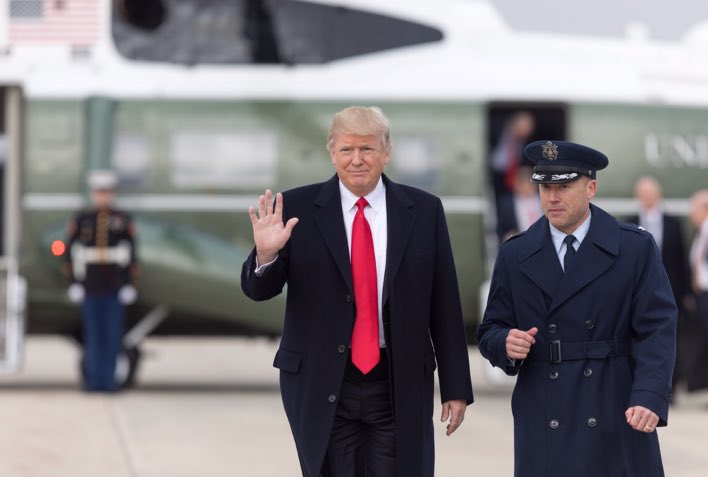
President Donald Trump (photo: @POTUS)
In the weeks before Donald Trump’s address to Congress, the main topic of conversation among Democrats was not how to make the president look incompetent and unfit—it was how to best exploit the fact that he so clearly is.
We underestimated him.
In the biggest political rope-a-dope of all time, after setting the bar as low as he could during 40 days of tumultuous terribleness and a chaotic campaign, Trump delivered a well-crafted, coherent and populist-yet-serious speech on Tuesday night. His presidency re-started today, powered by its success.
In other words, this is the Democrats’ worst nightmare.
As unpopular a president as Trump is, a high percentage of American voters approve of his policies when they put aside their personal feelings about Trump himself. That means he may still be able to be a well-thought-of president—if he can just act, well, presidential.
And that’s what he did last night.
Trump will now undoubtedly get a bump up in polls. He may even get a bit of a honeymoon period here similar to what presidents normally receive when they are first elected. It’s even possible most of the country will temporarily forget just how badly he and his people bungled the beginning of his presidency.
But the really scary thing for Democrats isn’t the speech; it’s what was in it. Though there were plenty of the same divisive ideas that are sure to enrage the liberal base, there was also plenty of bi-partisan policy and sentiment that is tough to argue with.
Ironically, that was the same strategy as another Comeback Kid, who just happens to be the husband of the Democratic candidate Trump beat in November. Yes, in addition to the red meat he threw his base, President Trump attempted to triangulate his way out of trouble on Tuesday, using Bill Clinton’s method of marginalizing dissent by siding with the opposition party.
A few examples of Trump tacking left include:
--Immigration. The president seemed to indicate he would accept legal status for some undocumented immigrants, saying “I believe that real and positive immigration reform is possible.”
--Paid maternity leave. The president went way left on a favorite policy of liberals, declaring, “My administration wants to work with members of both parties to make child care accessible and affordable, to help ensure new parents that they have paid family leave.”
--Lowering the cost of prescription drugs. Traditionally an issue for Democrats, Trump announced (for the umpteenth time) that he would “work to bring down the artificially high price of drugs.”
Trump also made plenty of inarguable - and stereotypically presidential - statements in his speech. He decried hate crimes. He called for unity. He laid praise on the military. Sure, some of it sounded hollow and pandering. But he didn’t smirk or flub or appear indifferent. In fact, he delivered the lines believably.
You’d have to remember that he has said racist things, divided Americans for his own benefit, and criticized a war hero for getting caught by the enemy to be offended by his duplicity. A lot of Americans won’t.
And to be turned off by his false statements, of which there were plenty, you’d have to know they were false. For the record, these included the claims that Americans live in “lawless chaos” (American crime rates are near all-time lows), “Obamacare is collapsing” (20 million more Americans have health insurance now who didn’t before the health plan was passed), and our country is undergoing the “worst financial recovery in 65 years” (75 months of straight job creation and historically low unemployment).
And, by God, it was great TV.
Maybe that shouldn’t be a surprise. After all, Trump is the producer of a top-rated show. But maybe you would think that a Trump-produced address of Congress would be too over the top to be convincingly earnest. It wasn’t.
The most memorable moment of the evening – or of any presidential address of Congress in recent memory – was the moving memorial for Senior Chief William Ryan Owens, a Navy SEAL killed in a counter-terror operation in Yemen. His wife, Carryn, appeared to be speaking skyward to her late husband as the chamber stood and applauded. The applause lasted for several minutes. Then, the president quoted the Bible in eulogy.
Perhaps Trump’s communications team was thinking more about the effect that moment would have on its principal’s approval rating than the importance of it for the widow and the appreciation of the ultimate sacrifice of a soldier. Perhaps not. It doesn’t matter. It made the president look presidential.
But the Democrats do have one thing going for them: this was just a speech. Today may be a brighter day for Republicans and the White House—but sunlight is the best disinfectant, and only progress on the president’s promises will allow him to maintain his momentum.
Plus: Trump is Trump. If history is any guide, he does not have the discipline to stay on message for more than a short time.
So chalk one up for Team Trump. And Democrats beware. But leading a divided nation, convincing a cantankerous Congress and advancing a bi-partisan agenda is a lot harder than reading off of a Teleprompter.
***
Evan Thies is the co-founder of Pythia Public Affairs. On Twitter @EvanRThies.
***
Have an op-ed idea or submission for Gotham Gazette? Email This email address is being protected from spambots. You need JavaScript enabled to view it.
To Secure Our Children’s Foundation, Honor Foundation Aid for Schools
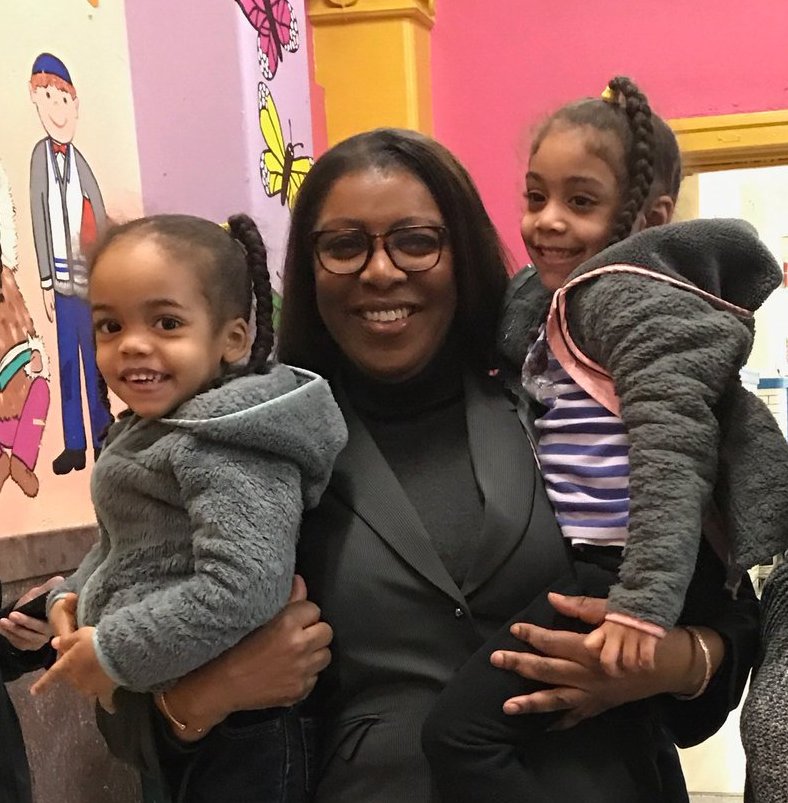
Public Advocate Letitia James, the author, with two children (photo: @TishJames)
With so much uncertainty in our country, there’s never been a more critical time to invest in our future and safeguard opportunities for our children. That’s why we must ensure that education funding is protected and our schools have the resources to prepare students for college and the job market.
Our children cannot perform at their best in overcrowded classrooms with outdated technology and slow internet access -- or, for that matter, with an obsession with test scores over well-rounded instruction. Our children cannot perform at their best if school libraries are closed, music and art classes are cut, and there is limited access to advanced courses. And our children cannot perform at their best if there is one guidance counselor for 800 students and no English language learning classes.
Perhaps unsurprisingly, the lack of funding that often leads to unacceptable educational environments disproportionately impacts low-income students and students of color. New York City is home to one of the most segregated school districts in the country, where 96 percent of black and 95 percent of Latino students attend majority low-income schools. Within this system, over three quarters of our public school students qualify for free or reduced-price school lunch, a universal metric for student poverty.
Every day that these students attend underfunded schools, they face both immediate setbacks in their daily lives and harm that is damaging to their futures. A recent study found that a 10 percent increase in school funding available for a low-income student results in a 9.5 percent increase in that student’s earning as an adult. With New York City schools owed almost $2 billion from the state, this is a legal and moral failing that we can no longer allow to persist.
While there is across-the-board agreement on the need to address these challenges, as a state we still haven’t put our money where our mouth is.
In 1993, New York City school parents sued New York State for failing to provide their children with the quality education they deserved. After a 13-year legal battle, in 2006, the state’s highest court found that New York State was failing to provide every student with the opportunity for a “sound basic education” due to lack of adequate funding.
Following the landmark ruling, then Governor Eliot Spitzer and the New York Legislature created the Foundation Aid formula to ensure schools in New York State were being funded. For two years, New York State increased funding to public schools -- a welcome boon to students who were struggling to receive sound basic education. Then the Great Recession hit and spending was cut across sectors, including education. This effectively reversed the two years of increases and further cut already lacking funds.
Our economy rebounded from the recession years ago, but funding for our schools has not been restored. Put simply: our state government refuses to prioritize the education of our students in public schools.
It’s alarming that Governor Andrew Cuomo’s proposed 2017-18’ budget does not adhere to the Foundation Aid formula – a failing that will rob our schools of the resources they are entitled to.
If we believe a high quality education is the foundation for our children’s success, the Governor and the Legislature must restore Foundation Aid and live up to our state’s legal and moral responsibility.
We owe it to our children.
***
Letitia James is the Public Advocate of New York City. On Twitter @TishJames.
***
Have an op-ed idea or submission for Gotham Gazette? Email This email address is being protected from spambots. You need JavaScript enabled to view it.
A Blueprint for Investing in Vulnerable Young Girls
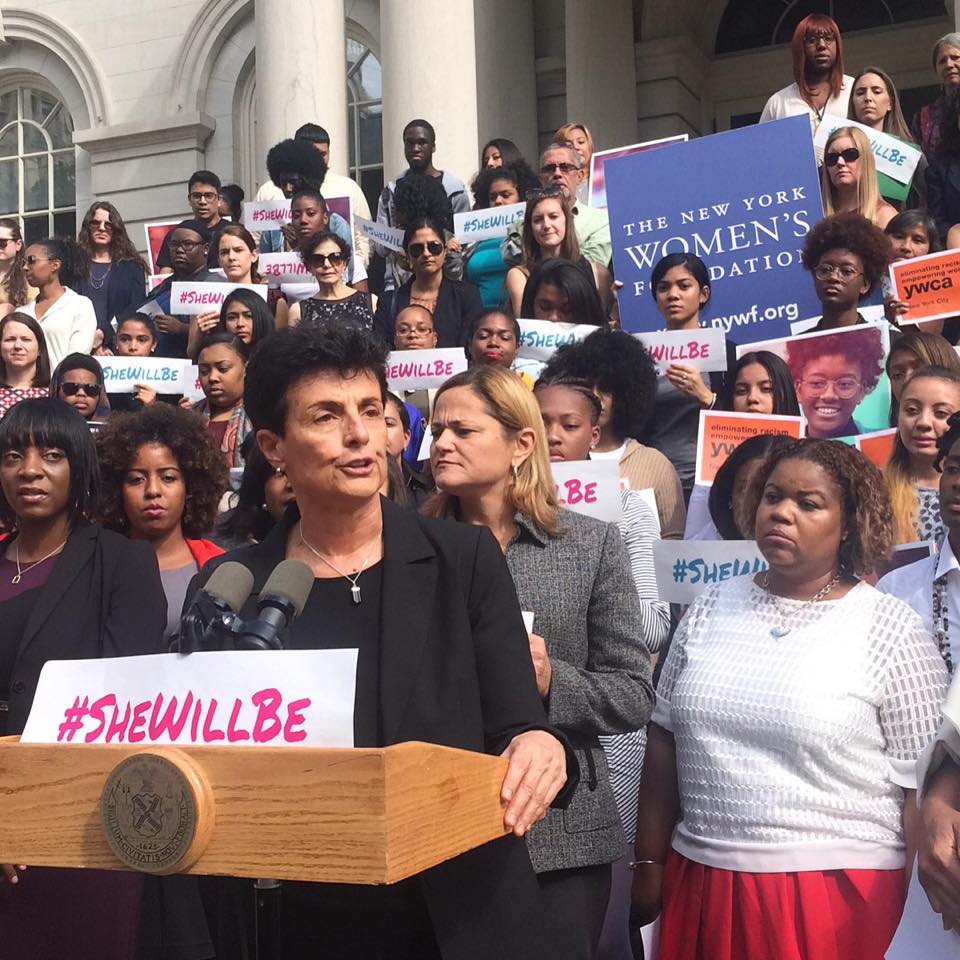
Ana Oliveira, the author
A study released last month in the journal Science found that by age six, girls are already less likely to see themselves and other girls and women to be as brilliant and capable as boys. While this applied to girls regardless of race and income, a report released in November by The New York Women’s Foundation highlights the particular challenges faced by low-income girls, particularly immigrant girls and girls of color, and the critical need to support their mothers and caretakers in order to promote their progress.
New York City is home to 450,000 girls under the age of eight. Fully three-quarters live in communities of color or immigrant communities. As many as 40% live in poverty.
These girls clearly embody the vibrant, diverse future of our city. Last fall, every poster announcing New York’s new universal pre-K program prominently displayed at least one of those little girls’ shining faces, inspiring deep feelings of warmth and protectiveness.
The problem is that tender feelings and a single additional year of schooling are far from sufficient to meet these girls’ needs. The first eight years of a child’s life comprise a period of both unique vulnerability and unparalleled cognitive, physical, and social-emotional development. Ensuring solid health and progress for low-income girls thus requires ensuring that they receive strong, consistent nurturance from well-supported and well-prepared adults – 24/7 – across all those critical years of learning and growth.
And that is where we run into trouble.
Our report, Blueprint for Investing in Girls Age 0-8 from The New York Women’s Foundation, clearly shows that our society has remained stubbornly resistant to adopting measures that would ensure fair protection, just compensation, adequate support, and strong preparation to the low-income women of color who are raising these girls.
Here are the facts:
--Low-income mothers have highly-limited access to the basic guidance, reassurance, and respite that all mothers need to be effective nurturers and first teachers. While mothers of means can typically avail themselves of an array of supports – from culturally-appropriate parenting groups to knowledgeable nannies to classes explaining just how to boost a child’s reading skills – there exist no comparably- and consistently-accessible resources for all the low-income mothers whose core childrearing challenges are inevitably further exacerbated by the tolls of poverty.
--Low-income women of color are overwhelmingly both the main (or sole) wage earners and the main (or sole) caregivers for their families. They are concurrently responsible for paying their families’ core bills, providing or arranging for their children’s round-the-clock care, and serving as the backbone of our city’s low-wage workforce. Yet, New York City currently provides only some 36,000 slots of direct, subsidized childcare to cover the needs of the hundreds of thousands of working mothers who cannot possibly afford market-rate care. And even the families that qualify for the subsidy often find the slots to be geographically inaccessible, financially unaffordable, or unavailable at the moment that they need them.
--The (predominantly non-white, female) workers who staff the city’s subsidized childcare programs earn salaries that put them barely over the poverty line themselves. And the even larger cadre of informal caregivers employed by most working mothers have only limited access to the ongoing training, support, feedback, and supervision that their vitally-important work merits – and requires.
--The service and retail jobs that low-wage working women overwhelmingly hold are typically characterized by minimal pay scales, erratic hours, and total lack of flexibility. Low-wage working mothers therefore not only battle to simultaneously meet their families’ caregiving and economic needs – they struggle fiercely to dovetail those childcare arrangements to the sudden fluctuations of their working hours and to ensure that someone is on hand to handle the emergencies that can arise in any family.
Fortunately, the situation is not completely grim. Across the city, a range of sterling efforts are leading the way to improvement on all those critical fronts.
They include:
--The Nurse-Practitioner Partnership and Healthy Families programs, which offer up to two years of intense, culturally-appropriate in-home guidance and support to a small but crucial segment of the city’s youngest and most vulnerable mothers.
--A range of service agencies – like BOCNET, Whedco and the five members of the Child Care Resource and Referral Consortium (CCRC) – that are working to improve and extend low-wage families’ access to high-quality affordable childcare and provide robust training and supports to formal and informal childcare providers.
--A group of advocacy organizations – for example, A Better Balance – which are doggedly seeking fairer and more viable employment practices and conditions for working parents.
These and other similar efforts are creating a track record of solid success. All are eminently expandable and replicable – given the will and the resources.
The experts strongly agree: If we want the low-income girls of our city to be as healthy, stable, and successful as possible, we need to better recognize, respect, and bolster the strengths of the low-income women of color who hold these girls’ futures in their hands.
For not only are those women these girls’ main caregivers and providers, they are also their main role models. And so, if we continue to underpay, exploit, and under-support those adult women, we are offering those girls a very discouraging vision of their own potential adult destinies.
Don’t we owe the future leaders of our families, communities, and workforce something better than that?
***
Ana Oliveira is President & CEO of The New York Women’s Foundation.
***
Have an op-ed idea or submission for Gotham Gazette? Email This email address is being protected from spambots. You need JavaScript enabled to view it.
No Path for Cuomo 2020
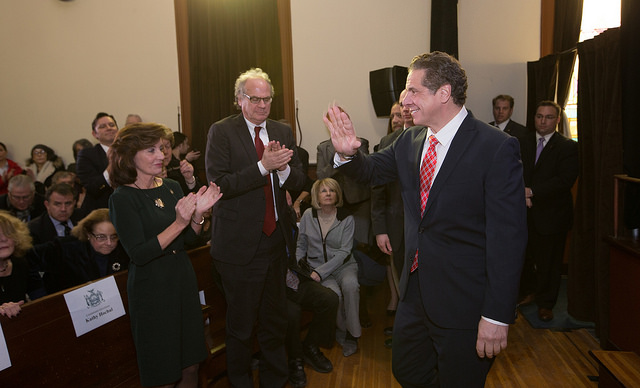
Gov. Cuomo (photo: The Governor's Office)
Governor Andrew Cuomo’s unconventional whirlwind State of The State tour has, once again, gotten political pundits pondering the depths of his national ambition, three years out from the next Presidential election.
Much like his father Mario’s legendary Danish Prince act in 1988, as well as his encore performance of 1992, Cuomo the Younger has openly flirted with a White House bid of his own in the past, and with the Democratic bench now resembling an intramural volleyball team, you’d think the chances of Cuomo securing his party’s nomination would be looking pretty good.
Assuming his ever-expanding campaign coffers, currently $21.9 million fat, buy him a third term as governor in 2018, Cuomo would then enter 2020 an automatic top-tier presidential candidate. But what’s his constituency?
Cuomo will likely have to compete with charismatic rock star candidates Cory Booker and Elizabeth Warren, maybe even Kamala Harris, in addition to Amy Klobuchar, Chris Murphy, Martin O’Malley, and possibly his own home state’s junior Senator Kirsten Gillibrand, though she says her primary focus is running for re-election next year. Colorado Governor John Hickenlooper might also join the fray, among others.
After accepting $18 million in campaign contributions from the financial, real estate, lobbying, and insurance industries, it is doubtful Cuomo’s candidacy would resonate very deeply amongst the fiercely populist, anti-corporate liberal grassroots millennials and other left wing special interest groups that are a natural fit for Senators Warren and Booker.
Meanwhile, others, like O’Malley and Gillibrand, might find common cause with the more centrist New Democrats of the Clinton era – a group that ought to be a key Cuomo demographic.
But why would Iowa caucus-goers cast their vote for a career politician and successor to a nearly 40-year-old political dynasty rather than a fresh face? What does New Hampshire get with Cuomo that they don’t get with someone like Warren? Will African-Americans in South Carolina pull the lever for a 63-year-old Italian-American from Queens if Cory Booker or Kamala Harris is on the ballot?
Since being sworn in six years ago, Andrew Cuomo has largely toed the yellow middle line of caution, displeasing hardcore Democrats enough to draw two primary challengers in 2014, who went on to garner 40% of the vote. Cuomo’s infamous Working Families Party “hostage video” is a stark reminder that Cuomo has struggled to consolidate or inspire the base of his party. “Progressive” efforts since have smacked of desperation as he apparently eyes 2018 and 2020. Most Democrats in New York still don’t trust Cuomo.
And if he can’t inspire the base then how can he expect to emerge triumphant from a Presidential primary rife with younger, more appealing progressive leaders?
On Cuomo’s watch, New York has become a state with the second highest debt in the nation, according to the most recent U.S. Census Bureau data (2014); second highest Medicaid costs, based on a 2015 Kaiser Family Foundation analysis; seventh highest income tax rate; eleventh highest property tax rate; a shrinking population; crumbling infrastructure; habitual spending increases; and 3 million residents receiving food stamps.
Also, lest we forget, the governor’s second term has so far seen the convictions of both former Assembly Speaker Sheldon Silver and State Senate Majority Leader Dean Skelos on charges of corruption, as well as the arrests of top Cuomo advisor Joe Percoco, former aide Todd Howe, SUNY Polytechnic Institute President Alain Kaloyeros, and seven others amidst a massive bid-rigging and corruption scandal.
Were he to run for President, it seems unlikely Cuomo would be able to escape the ubiquitous scrutiny of his administration’s failed ethics as well as its failure to provide substantive ethics reform to New York government and politics.
Cuomo has made a career out of being a pragmatist. Despite all the buzz from talking heads trying to fill out their round-the-clock coverage, even he would begrudgingly admit that a third term in Albany might very well prove to be the apex of his decades long political career.
***
John William Schiffbauer was the Deputy Communications Director for the New York Republican State Committee 2014-16. Last fall, he served as campaign manager for Republican Melinda Crump’s State Senate campaign in New York’s 31st District.
***
Have an op-ed idea or submission for Gotham Gazette? Email This email address is being protected from spambots. You need JavaScript enabled to view it.
Broken Windows Policing Will Fuel the Trump Deportation Machine
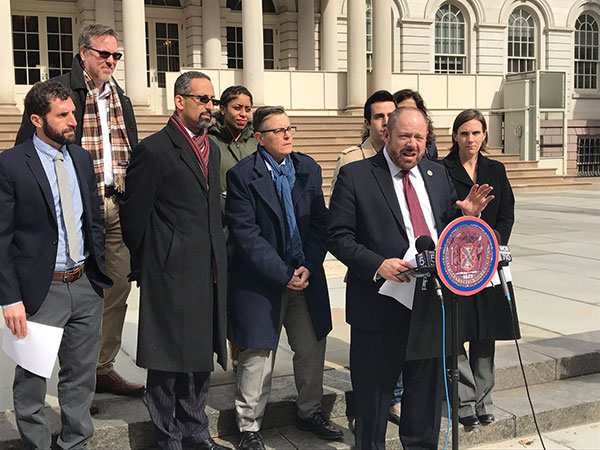
City Council Member Rory Lancman, the author (photo: @RoryLancman)
We’re now more than 30 days into Donald Trump’s presidency, and it is already crystal clear that the hostile and offensive rhetoric he used toward immigrants on the campaign trail will be put into practice by his administration.
It was just this week that Trump’s Department of Homeland Security issued new rules that make clear Trump’s plan to deport millions of immigrants from our country, while tearing apart families and communities in the process.
With thousands, if not tens of thousands, of immigrant New Yorkers now at risk of deportation, it is urgent that Mayor Bill de Blasio take real action to protect immigrant New Yorkers from possible deportation under Trump.
The mayor has had no problem in recent weeks talking about opposing Trump and his policies, but when it comes down to it, talk is cheap. Real leadership requires bold action, and immigrant New Yorkers deserve action.
But, here is the reality facing New York City today: Mayor de Blasio’s broken windows policing will now be the fuel for Donald Trump’s deportation machine.
Without important and necessary action from the mayor, New Yorkers who are arrested for minor, nonviolent offenses could now be subject to deportation. That is inhumane and completely contrary to our values.
Mayor de Blasio has the authority to take action immediately to protect immigrant New Yorkers -- without having to wait for the City Council, the State Legislature, or Congress. On his own, the mayor can direct the NYPD to stop arresting people, including immigrant New Yorkers, for low-level, nonviolent, quality-of-life crimes where a civil alternative is already readily available.
Take fare evasion, for example. In 2015, more than 100,000 New Yorkers were stopped by the NYPD for fare evasion. Nearly 30,000 New Yorkers were arrested for “theft of services,” a misdemeanor under the state penal law. The remaining individuals were issued a civil summons for violating the MTA rule against fare evasion, which is not subject to any kind of criminal sanction.
The difference between an arrest and a civil violation for fare evasion is monumental. A conviction for fare evasion could result in jail time, appear on an individual’s criminal record, and staggeringly enough, result in deportation for even documented immigrants like legal permanent residents of New York.
On the other hand, a civil violation is heard by the MTA’s Transit Adjudication Bureau, not a criminal court, and cannot result in jail time or deportation.
As Mayor de Blasio’s broken windows policing continues in this city, it is clear who is being targeted -- 92% of the arrests for fare evasion in 2015 were people of color. Oftentimes, too, if an individual cannot immediately produce an ID, the NYPD will choose to make an arrest, instead of issuing a civil violation.
All told the risk of arrest for immigrant New Yorkers for fare evasion is all too real. And for undocumented immigrants, any interaction with the criminal justice system, even for a minor offense like fare evasion, can result in deportation.
With the stakes so high for so many in our city, it is up to the mayor to determine if he is going to use his authority to protect people, or silently feed into Trump’s deportation machine. Talking about standing up to Donald Trump is one thing, but actually taking action is far more important.
New Yorkers are counting on the mayor to do what’s right and take a real, actionable stand for our values against Trump.
***
City Council Member Rory Lancman represents parts of Queens and chairs the Council's Committee on Courts and Legal Services. On Twitter @RoryLancman.
***
Have an op-ed idea or submission for Gotham Gazette? Email This email address is being protected from spambots. You need JavaScript enabled to view it.
Building a New Future for Low-Income New Yorkers
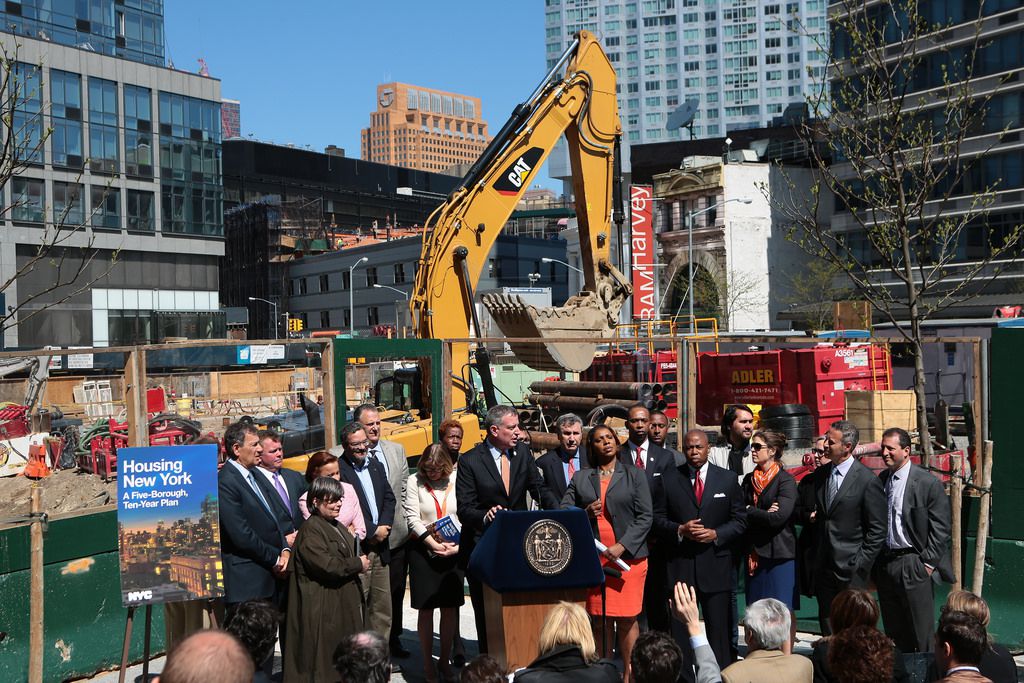
Mayor de Blasio at a ground-breaking (photo: The Mayor's Office on Flickr)
Mayor Bill de Blasio recently announced that he will allocate much-needed additional funds to increase housing opportunities for 10,000 low-income families and seniors citywide. The New York State Association for Affordable Housing (NYSAFAH) commends the mayor on providing nearly $2 billion in new housing subsidy for low-income families, which will further alleviate New York City’s housing crisis by maximizing low-income housing production.
Now it is time to put those resources to work by moving past anti-development attitudes that have distorted the conversation around affordable housing for too long.
Affordable housing builders have – with limited resources – already made important strides to house low-income New Yorkers under Mayor de Blasio’s leadership, with more than 13,000 homes built and preserved for households at or below 50 percent of area median income (AMI).
NYSAFAH and its members have long made it clear that we are prepared to do more for New York’s lowest income families and so have continually advocated for the additional resources necessary to build this housing. Every New Yorker deserves access to safe, quality affordable housing and we will not stop until that mission is accomplished.
To understand the real value of this announcement, we must recognize the previous lack of financial assistance available to build housing for very-low and low-income New Yorkers.
The efforts of affordable housing developers have been hindered by federal, state, and local program provisions under which NYSAFAH’s members can build. Additionally, due to the rising cost of land and construction in New York, it has been nearly impossible to build new housing for the lowest income families without the offset of units for higher-earning households in the low- and middle-income brackets. The mayor’s new subsidy will allow developers to specifically address the needs of those making less than $40,000 per year.
Too often critics of smart development have distorted reality by falsely claiming that developers have purposely not paid enough attention to low-income housing. These critics, backed by politically motivated construction unions, have tried to convince New Yorkers and elected officials that the problem lies with developers rather than to acknowledge the obvious lack of resources required to build much-needed homes. The attacks on affordable housing builders have for a long time ignored the fiscal reality of what is required to support low-income families and maintain their homes with a fixed rental income stream.
Another lesser known fact is that affordable housing developments remain under long-term affordability agreements for 25 years or more, despite the reality of costly changes to market conditions and utilities. With the recognition by Mayor de Blasio that there is need for more subsidy, we can continue to take steps to unlock the full potential of low-income housing development.
We must move beyond the political posturing and rhetoric, and every single stakeholder must work in partnership to positively transform the lives of low-income families across the five boroughs. NYSAFAH members are ready to do just that – and we hope that others will join us in building a better future for every New Yorker.
***
Jolie Milstein is president and CEO of the New York State Association for Affordable Housing (NYSAFAH).
***
Have an op-ed idea or submission for Gotham Gazette? Email This email address is being protected from spambots. You need JavaScript enabled to view it.
Jobs of the Future Come From The Right Education
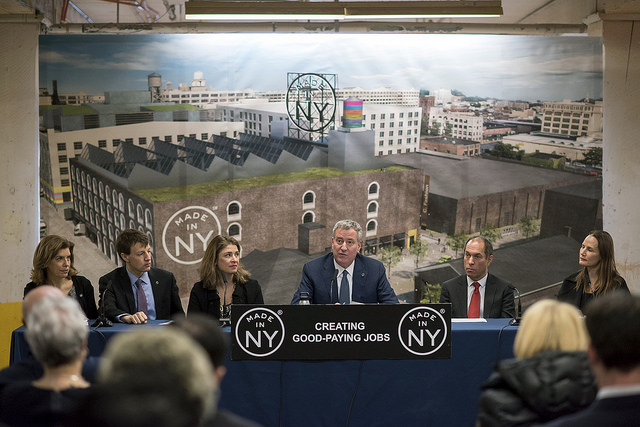
Mayor Bill de Blasio (photo: Ed Reed/Mayor's Office)
In his State of the City speech last week, Mayor Bill de Blasio spoke of the need to create 100,000 good jobs for New Yorkers in the coming decade. He defined “good jobs” as those which pay more than $50,000 a year and talked about encouraging various sectors of the economy, like technology, that have average salaries that pay even more. To his credit, the mayor talked about creating good jobs that don’t necessarily require a college degree, like construction, but he also recognized the important role advanced education plays in attaining many well-paying technology-based jobs that are at the core of our globalized economy.
I think that’s great, but if the jobs to be created are to be held by New Yorkers – meaning children from every community who are educated in our city’s schools, whether they are native-born or immigrants – his administration must do more to prepare our city’s children for the STEM (Science, Technology, Engineering and Math) jobs of the future.
Sadly, according to a report by the New York City Comptroller’s office, which relied on Department of Education statistics, “only about one-fifth of the City’s new college-degreed entrants to its workforce...are products of the City’s school system.”
Critics of the mayor’s speech suggest that he can do little to actually promote the creation of such jobs for New Yorkers. I disagree. The city needs to spend more money where it will do the most good to prepare our children for the high tech jobs of the future, and that means spending more on STEM education in our public schools.
A dramatic example of the underfunding of STEM education in our city is Brooklyn Technical High School, where I head the Alumni Foundation. Brooklyn Tech receives only 87.6 percent of the annual funding required under the city’s fair funding formula. That means it is shortchanged about $1 million a year. While Tech ranks consistently in the top schools in our nation and our state, this chronic underfunding is short changing six thousand of the best and brightest students of our city. The school simply cannot offer the number and variety of advanced placement courses that the students could and should be taking.
Even more troubling is the city’s failure to keep the school’s physical infrastructure - its elevators, boilers, plumbing, and electrical systems - up to date. Some of it is simply too old to be reliable and some, like the electrical, is not distributed properly throughout the school to service the needs of modern classroom computerization. The alumni recently commissioned a professional study of the building, which occupies a square city block. It showed that it would cost about $300 million to recapitalize the 80-year-old building and make it into a modern vertical campus. To replace the building would likely cost three times as much.
Brooklyn Tech has a long history of educating the children of the city’s working families – whether New York-born or from other countries – and preparing them for the world of work. Admittedly in my day, nearly 50 years ago, we learned how to operate metal lathes and pour molten lead in the foundry. Today’s modern curriculum allows students to major in many engineering fields as well as quantitative finance, law and medicine (That’s right, Brooklyn Tech has majors like a college.) Brooklyn Tech accounts for a large percentage of all the AP courses taken in the city, but at the same time, it also graduates hundreds of students each year who have industry-recognized certifications needed to get a job.
If the city wants to prepare New Yorkers for the good jobs that exist today, and in the future, it should increase funding for STEM education to 100 percent of the fair funding formula, not only at Brooklyn Tech but at other city high schools – and not only the eight test-in schools like Tech, Stuyvesant and Bronx Science, but others across the city committed to educating our children in the critical STEM curriculum.
For Brooklyn Tech, that also means the city should embark on a ten-year program to rehabilitate its building. Not only would this properly prepare today’s students for the jobs of the future, it would also create high-paying construction jobs for thousands of our city’s workers.
***
Larry Cary is a Manhattan lawyer and president of the Brooklyn Tech Alumni Foundation.
***
Have an op-ed idea or submission for Gotham Gazette? Email This email address is being protected from spambots. You need JavaScript enabled to view it.




